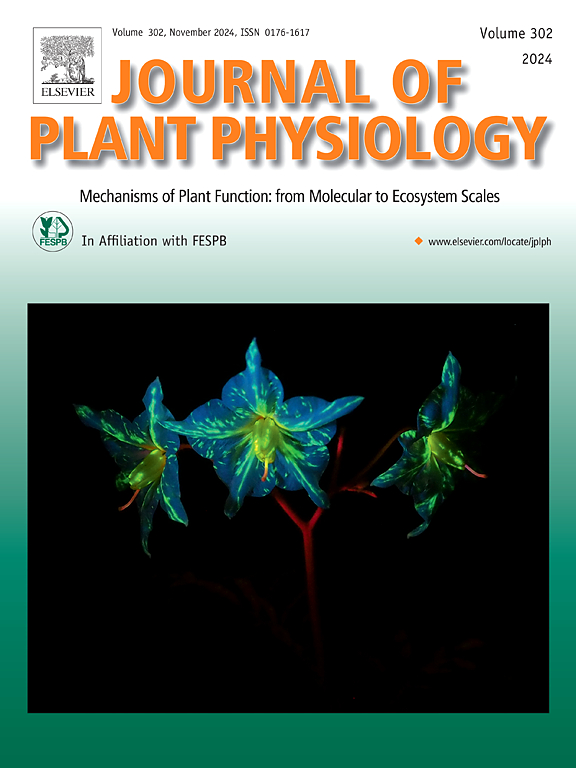Soluble sugars maintain redox homeostasis and accelerate the growth of cultured Malva neglecta cells under 2D-clinorotation
IF 4.1
3区 生物学
Q1 PLANT SCIENCES
引用次数: 0
Abstract
In addition to their nutritional role, carbohydrates play essential roles in metabolism, growth, development, and response to the environment. In the present study, the effects of clinorotation on structural and soluble sugar metabolism and the redox system were investigated in cultured Malva neglecta cells. A rapidly growing cell line was established from leaf explants of M. neglecta on a solidified LS medium, and the cells were exposed to 2D-clinostat for 7 days. Clinorotation significantly increased monosaccharide content, including glucose, fructose, rhamnose, mannose, and xylose, while reducing sucrose levels compared to control groups. The activities of pectin methylesterase (PME) and β-1, 3-glucanase increased, whereas those of covalently wall-bound peroxidase (CPO) and polyphenol oxidase (PPO) decreased. This reduction, along with a decrease in callose, cellulose, and phenolic acid content, likely accelerated cell growth by reducing cell wall crosslinking and stiffness. The content of reactive oxygen/nitrogen species i.e., hydrogen peroxide (H2O2), hydroxyl radical (.OH), and nitric oxide (NO) radicals significantly decreased in response to clinorotation compared with 1g-grown cells. Hierarchical cluster analysis revealed a strong negative correlation between NO and catalase (CAT) activity. The observed decrease in these oxidants can be attributed, at least in part, to the increased content of soluble sugars through the oxidative pentose-phosphate pathway or tricarboxylic acid cycle (TCA), and more significantly, to the enhancement of catalase activity and flavonoid content.
可溶性糖维持氧化还原稳态,并加速培养的忽视Malva细胞在2d染色下的生长
除了营养作用外,碳水化合物在代谢、生长、发育和对环境的反应中也起着至关重要的作用。在本研究中,研究了旋转对培养的Malva malecta细胞结构和可溶性糖代谢以及氧化还原系统的影响。将M.忽略草叶片外植体在凝固的LS培养基上建立快速生长细胞系,并将细胞暴露于2D-clinostat中7天。与对照组相比,前旋处理显著增加了单糖含量,包括葡萄糖、果糖、鼠李糖、甘露糖和木糖,同时降低了蔗糖水平。果胶甲基酯酶(PME)和β- 1,3 -葡聚糖酶活性升高,共价壁结合过氧化物酶(CPO)和多酚氧化酶(PPO)活性降低。这种减少,以及胼胝质、纤维素和酚酸含量的减少,可能通过减少细胞壁交联和硬度来加速细胞生长。与1g培养的细胞相比,过氧化氢(H2O2)、羟基自由基(. oh)和一氧化氮(NO)自由基等活性氧/氮物质的含量显著降低。分层聚类分析显示NO与过氧化氢酶(CAT)活性呈显著负相关。观察到的这些氧化剂的减少可以归因于,至少部分归因于通过氧化戊糖-磷酸途径或三羧酸循环(TCA)增加的可溶性糖含量,更重要的是,过氧化氢酶活性和类黄酮含量的增强。
本文章由计算机程序翻译,如有差异,请以英文原文为准。
求助全文
约1分钟内获得全文
求助全文
来源期刊

Journal of plant physiology
生物-植物科学
CiteScore
7.20
自引率
4.70%
发文量
196
审稿时长
32 days
期刊介绍:
The Journal of Plant Physiology is a broad-spectrum journal that welcomes high-quality submissions in all major areas of plant physiology, including plant biochemistry, functional biotechnology, computational and synthetic plant biology, growth and development, photosynthesis and respiration, transport and translocation, plant-microbe interactions, biotic and abiotic stress. Studies are welcome at all levels of integration ranging from molecules and cells to organisms and their environments and are expected to use state-of-the-art methodologies. Pure gene expression studies are not within the focus of our journal. To be considered for publication, papers must significantly contribute to the mechanistic understanding of physiological processes, and not be merely descriptive, or confirmatory of previous results. We encourage the submission of papers that explore the physiology of non-model as well as accepted model species and those that bridge basic and applied research. For instance, studies on agricultural plants that show new physiological mechanisms to improve agricultural efficiency are welcome. Studies performed under uncontrolled situations (e.g. field conditions) not providing mechanistic insight will not be considered for publication.
The Journal of Plant Physiology publishes several types of articles: Original Research Articles, Reviews, Perspectives Articles, and Short Communications. Reviews and Perspectives will be solicited by the Editors; unsolicited reviews are also welcome but only from authors with a strong track record in the field of the review. Original research papers comprise the majority of published contributions.
 求助内容:
求助内容: 应助结果提醒方式:
应助结果提醒方式:


